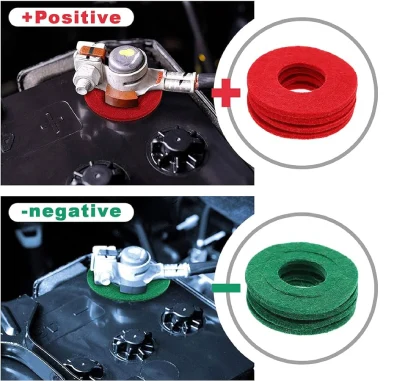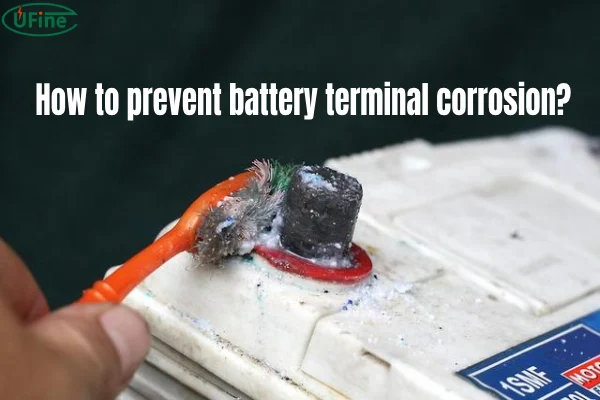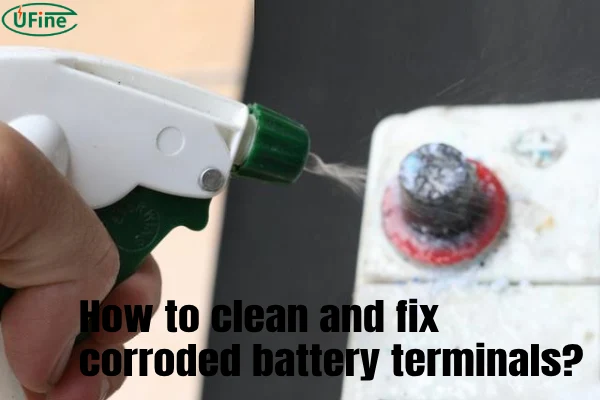Ever had your car battery die on you, leaving you stranded in the middle of nowhere? Or maybe you’ve noticed your car struggling to start, with dim headlights and sluggish performance? These could be signs of a common problem: battery terminal corrosion.
While it may sound intimidating, battery terminal corrosion is actually a relatively straightforward issue to understand and fix. Think of it like a slow build-up of rust on metal, but in this case, it’s happening on the crucial connection points between your battery and the rest of your car’s electrical system.
How to Identify Lithium Battery Terminals?
This article will delve into the world of battery terminal corrosion, explaining what causes it, how to identify the signs, and most importantly, how to prevent and fix it. Let’s dive in!
Part 1. What is battery terminal corrosion?
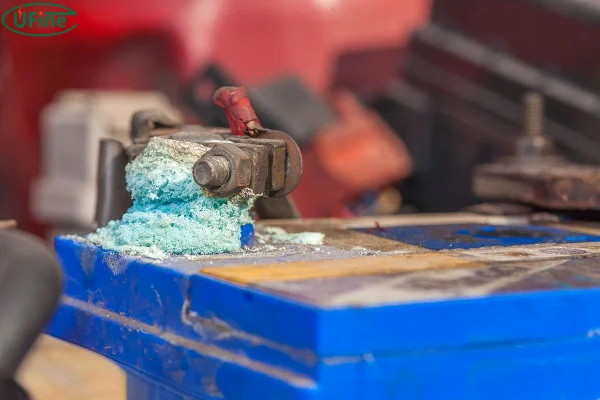
Battery terminal corrosion is a chemical reaction that occurs when the battery’s electrolyte, a mixture of acids and water, leaks out and reacts with the air. This reaction creates a white, green, or blue powdery substance that builds up on the battery terminals. This substance is actually a combination of lead sulfate, lead oxide, and lead carbonate.
While seemingly harmless, this corrosion can create a significant problem. It acts as an insulator, hindering the flow of electricity between the battery and the car’s electrical system. This can lead to a variety of issues, including:
- Difficult Starting: The car struggles to turn over, requiring multiple attempts to start.
- Dim Lights: Headlights and interior lights may appear dimmer than usual.
- Sluggish Performance: The car may lack power and acceleration.
- Electrical Problems: Other electrical components, such as the radio, power windows, and air conditioning, may malfunction.
Positive Battery Terminal Corroded
The positive battery terminal is the red cable connection, and it’s often the one that shows the most corrosion. Here’s why:
- Higher Voltage: The positive terminal carries a higher voltage, which can accelerate the corrosion process.
- Sulfation: Lead sulfate, a common component of battery corrosion, tends to form more readily on the positive terminal.
- Heat: The positive terminal can get hotter than the negative terminal, which can also contribute to corrosion.
Negative Battery Terminal Corroded
The negative battery terminal is the black cable connection. While it’s less prone to corrosion than the positive terminal, it can still be affected. Here’s what to look for:
- Green or Blue Corrosion: Corrosion on the negative terminal is often green or blue, indicating the presence of lead oxide or lead carbonate.
- Loose Connections: Corrosion on the negative terminal can make the cable connection loose, leading to poor electrical conductivity.
Part 2. What causes battery terminal corrosion?
Several factors contribute to battery terminal corrosion:
- Electrolyte Leakage: As mentioned earlier, the battery’s electrolyte is a mixture of acids and water. Over time, this electrolyte can evaporate and leak out of the battery through the vent caps. This leakage is often accelerated by extreme temperatures, especially hot weather.
- Moisture: High humidity and condensation can also contribute to corrosion. The moisture in the air reacts with the battery terminals, leading to the formation of the corrosive substance.
- Environmental Factors: Salt air, pollutants, and even bird droppings can contribute to corrosion. These substances can react with the battery terminals, accelerating the corrosion process.
- Battery Age: Older batteries are more prone to leakage and corrosion. This is because the battery’s internal components degrade over time, making it more likely for the electrolyte to leak out.
Identifying the Signs of Battery Terminal Corrosion
Recognizing the signs of battery terminal corrosion is crucial for preventing further damage. Here’s what to look for:
- White, Green, or Blue Powder: A white, green, or blue powdery substance on the battery terminals is a clear indication of corrosion.
- Corrosion on the Battery Posts: The battery posts, the metal parts that connect to the cables, may also show signs of corrosion.
- Loose Connections: The cables may be loose or difficult to remove from the battery terminals due to corrosion.
- Clicking Noise: You may hear a clicking noise when you try to start the car, indicating that the battery is not making a good connection.
Part 3. How to prevent battery terminal corrosion?
Preventing battery terminal corrosion is easier than fixing it. Here are some simple steps you can take:
- Keep the Battery Clean: Regularly clean the battery terminals and surrounding area with a wire brush or a toothbrush. This will remove any accumulated dirt, grime, and corrosive residue.
- Apply a Protective Coating: After cleaning, apply a thin layer of petroleum jelly or battery terminal protector to the terminals. This will create a barrier against moisture and prevent corrosion.
- Use Battery Terminal Covers: Battery terminal covers are available at most auto parts stores. These covers help to keep moisture and debris away from the terminals.
- Check the Battery Regularly: Inspect your battery regularly for signs of corrosion. Early detection can prevent more serious problems.
- Replace Old Batteries: If your battery is old or shows signs of leakage, consider replacing it. This will help to prevent corrosion and ensure that your car’s electrical system is functioning properly.
Part 4. How to clean and fix corroded battery terminals?
If you find corrosion on your battery terminals, don’t panic. You can usually fix it yourself with a few simple tools and supplies. Here’s how:
- Disconnect the Battery: Always disconnect the battery before working on it. Start by removing the negative cable (black cable) first, then the positive cable (red cable). This will prevent accidental sparks and potential electrical shocks.
- Clean the Terminals: Use a wire brush or a toothbrush to scrub away the corrosion from the battery terminals and posts. You can also use a baking soda and water paste to help loosen the corrosion.
- Clean the Cables: Clean the ends of the battery cables with a wire brush or a toothbrush. Make sure that the metal contacts are clean and free of corrosion.
- Apply a Protective Coating: After cleaning, apply a thin layer of petroleum jelly or battery terminal protector to the terminals and posts. This will help to prevent corrosion from returning.
- Reconnect the Battery: Reconnect the battery cables in the reverse order, starting with the positive cable (red cable) and then the negative cable (black cable).
Additional Tips for Preventing and Fixing Battery Terminal Corrosion
- Use a Battery Terminal Cleaner: Specialized battery terminal cleaners are available at most auto parts stores. These cleaners are designed to remove corrosion and leave a protective coating on the terminals.
- Consider a Battery Terminal Protector: Battery terminal protectors are small devices that fit over the battery terminals and help to prevent corrosion. They are a good investment if you live in a humid climate or experience frequent battery corrosion.
- Check the Battery’s Vent Caps: Make sure that the battery’s vent caps are clean and free of debris. This will help to prevent electrolyte leakage.
- Don’t Overtighten the Cables: Overtightening the battery cables can damage the terminals and make them more susceptible to corrosion. Tighten the cables securely, but don’t overtighten them.
Part 5. Final thoughts
Battery terminal corrosion is a common problem that can lead to a variety of electrical issues. By understanding the causes of corrosion and taking simple preventative measures, you can keep your battery healthy and your car running smoothly. If you do find corrosion, don’t hesitate to clean and fix it. With a little effort, you can prevent this common problem and avoid the frustration of a dead battery.
Related Tags:
More Articles
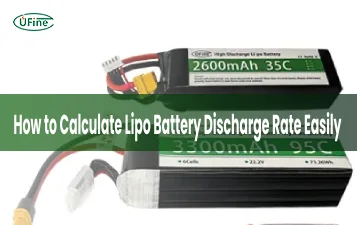
LiPo Battery Discharge Rate Guide & Calculation Tips
Understand LiPo battery discharge rates, C-ratings, and how to calculate max current. Essential guide for RC, drones, and electronics users.
High‑Capacity 3S LiPo Batteries: 5000 mAh vs. 10000 mAh
Compare 3S LiPo 5000mAh vs 10000mAh batteries by weight, power, and use. Find the best fit for your drone, RC car, or boat setup.
Top 5 Applications for Small 3S LiPo Batteries
Small 3S LiPo batteries power drones, RC gear, wearables, and robotics with high energy and low weight. Making them ideal for compact electronics projects.
Building and Charging Your Own 3S LiPo Pack: A Step‑by‑Step Guide
Learn how to build, balance, and charge a 3S LiPo battery pack safely at home with this complete DIY guide for hobbyists and beginners.
How to Choose the Right LiPo Battery Plug Type?
Discover the best LiPo battery plug types, how to choose them, and expert tips for safe usage, soldering, and maintenance.
